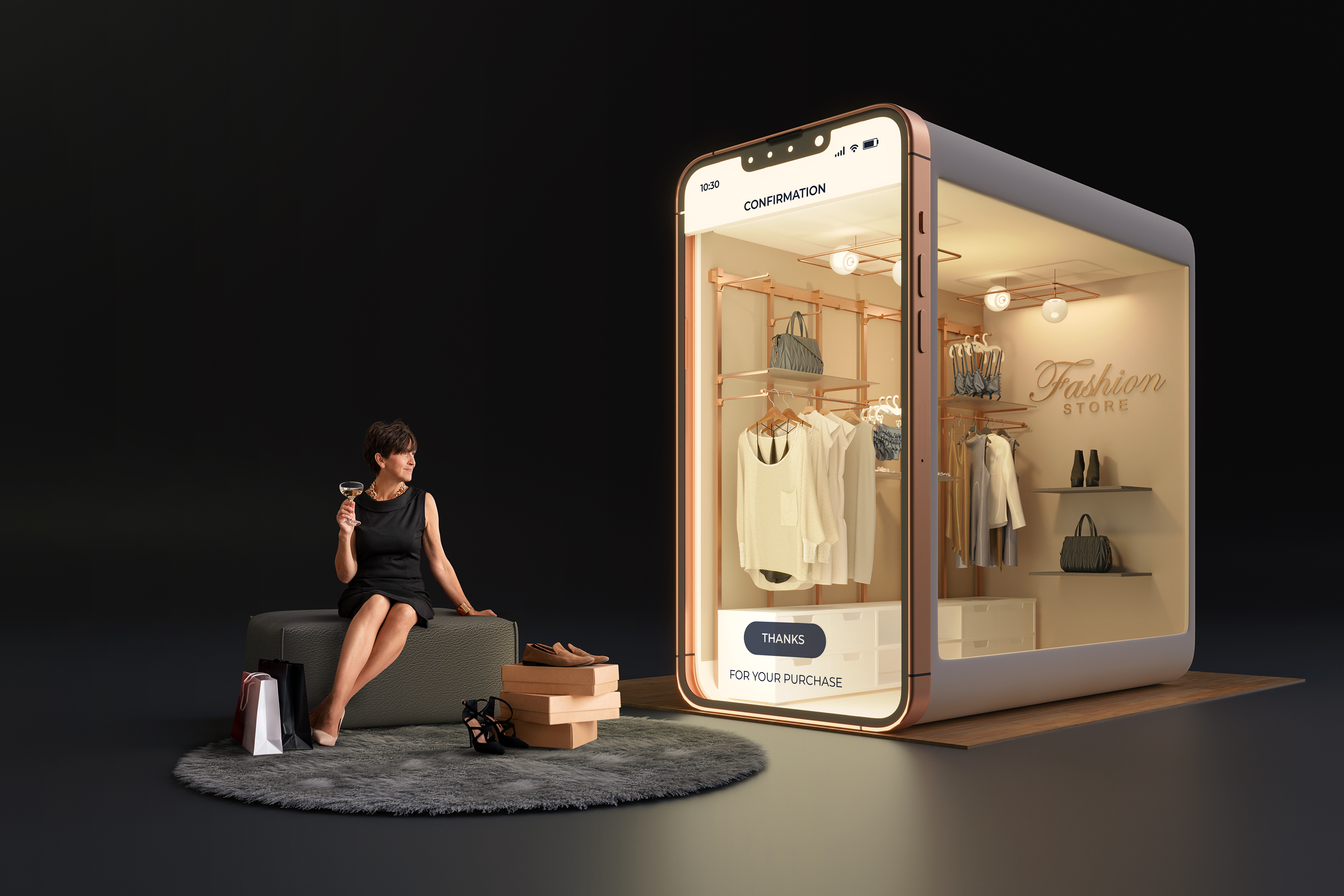
What Is Brand Experience, And Why Is It Important?
During the pandemic, one trend that reached its peak was online shopping. As per data, e-commerce sales increased by a whopping 67.9% between February 2020 and July 2022. While many might think the craze of online shopping might have decreased since then, but that isn’t the case. It continues to stay elevated in selected subsectors, including electronics, home furnishing, clothing and clothing accessories.
For many businesses, this shift to online-first purchasing brings numerous potentials. But it also lays the groundwork for various challenges. For instance, the surge in digital product offerings is also giving rise to the competition for customer conversions.
The consequence? A battleground for brand experience!
Are you wondering what brand experience is? Do you wish to know how it can come in handy in remaining relevant and driving sales? Find answers to everything below –
Understanding Brand Experience
Definition of Brand Experience
Brand experience is the essence of a brand brought to life. It’s not just a logo or a product – it’s the holistic encounter a customer has with your brand. It’s the lasting impression etched in their memory.
To simplify, brand experience is the sum of all interactions and perceptions a customer has with your brand. It’s the feeling they get, the emotions evoked, and the overall journey from discovery to purchase.
Essentially, it’s the story your brand tells without uttering a single word.
Elements that Contribute to Brand Experience
1. Physical Touchpoints
Physical touchpoints are the tangible encounters customers have with your brand. These include the storefront, product packaging, or even the business card handed out. They are the face-to-face moments that leave an imprint.
Every element, from the texture of your packaging to the layout of your store and even the ergonomic design of your product, may appear seemingly small. But, collectively, they shape a physical brand experience that lingers in the customer’s mind.
2. Digital Touchpoints
Your brand’s online presence is a vital touchpoint. For instance, your website, social media channels, and digital ads create a digital realm. This is where your brand interacts with its audience.
The user interface, the speed of your website, and the consistency of your messaging all contribute to the digital brand experience. They help you craft a seamless journey that transcends the physical boundaries, connecting with your audience on their screens.
3. Emotional Connections
Beyond the tangible and the digital, brand experience is deeply rooted in emotions. How does your brand make people feel? This is the emotional core of your brand identity.
An emotional connection is the glue that binds customers to your brand. It goes beyond the transaction, creating a bond that fosters loyalty. Whether it’s trust, joy, or a sense of belonging, these emotions are intangible yet powerful elements. They shape the overall brand experience.
Importance of Brand Experience

Building Customer Loyalty
Loyalty isn’t just about repeat transactions; it’s about forging a connection that makes your brand the preferred choice.
A positive brand experience creates a ripple effect, turning one-time buyers into loyal advocates. When new customers feel a genuine connection, when they resonate with your brand on a personal level, they not only return but become ambassadors, sharing their positive experiences with others.
Differentiating from Competitors
In a marketplace saturated with options, differentiation is the key to survival. Your brand experience is the secret weapon that sets you apart in the minds of consumers.
When competitors offer similar products or services, it’s the experience that becomes the deciding factor. It’s the way your brand communicates, the uniqueness it brings to the table, and the emotions it elicits that become the true differentiators.
Influencing Consumer Perceptions and Preferences
Perception is a reality in the world of branding. How consumers perceive your brand is as crucial as the actual products or services you provide.
A compelling and immersive brand experience shapes perceptions and influences preferences. It’s the reason why consumers choose your brand over others. It’s the intangible factor that makes your brand not just a choice but the preferred choice.
Hence, meticulously craft each touchpoint, from the physical to the emotional. This way, you can mould how consumers see and feel about your brand. This, in turn, will dictate their preferences, creating a gravitational pull that draws them towards your offerings.
The Role of Emotional Connection
Creating Memorable and Positive Emotions
Creating memorable and positive emotions is not just a branding goal; it’s the secret sauce that makes your brand unforgettable.
Think of the joy sparked by unwrapping a carefully packaged product or the sense of satisfaction after a seamless online shopping experience. These emotional peaks aren’t accidental; they’re meticulously designed moments that imprint positive feelings.
Crafting such moments isn’t just about selling a product; it’s about creating an emotional journey. Infuse joy, surprise, or even a touch of nostalgia into your brand experience to transform transactions into lasting memories.
Fostering a Sense of Belonging and Community
Humans are social creatures, and brands that tap into this innate need for connection stand out. Fostering a sense of belonging and community turns customers into more than just buyers; it turns them into members of a tribe.
From exclusive offers to community events, every touchpoint can reinforce the idea that being associated with your brand is not just a transaction but a shared identity. It’s about creating a space where customers feel understood, appreciated, and part of something larger than themselves.
When customers feel a sense of belonging, they are not just loyal; they become advocates who proudly recommend your brand to others.
The Impact of Emotional Resonance on Brand Loyalty
When a brand resonates emotionally, it transcends being a mere commodity; it becomes a trusted companion. The impact of emotional resonance on brand loyalty is profound. Customers don’t just choose your brand; they stay, they recommend, and they endure changes with you.
Every positive emotion strategically woven into the brand experience creates a thread of loyalty that binds customers to your brand. It’s not just about fulfilling a need; it’s about being a part of their story, making your brand a cherished chapter in the book of their lives.
Aligning with Brand Values
The Role of Shared Values in Brand Experience
Shared values form the bedrock of a profound brand experience. It’s not just about what your brand sells; it’s about what it stands for. Aligning with the values of your audience creates a resonance that goes beyond products and services.
Consider the values that matter most to your target demographic. Is it sustainability, innovation, or social responsibility? When your brand embodies these shared values, it creates a connection that transcends the transactional. It becomes a statement of identity for both the brand and the consumer.
In essence, shared values are the common language that bridges the gap between your brand and its audience. It helps form a bond that extends beyond the superficial.
Building Trust Through Consistent Alignment
Trust is the currency of brand loyalty, and consistent alignment with shared values is the roadmap to earning it.
Consistency is the linchpin. Whether it’s in your messaging, actions, or product development, aligning with brand values should be a steadfast commitment. This is because customers seek authenticity, and when your brand consistently lives up to its stated values, trust blossoms.
Also, trust, once earned, becomes the bedrock upon which a lasting brand-consumer relationship is built. It’s the assurance that every interaction with your brand will reflect the values that brought them into your fold in the first place.
Examples of Brands Successfully Aligning with Consumer Values
Numerous brands have masterfully aligned with consumer values, leaving an indelible mark on the market.
1. Patagonia exemplifies brand-to-value alignment, notably showcased in December 2017. When President Trump reduced protected land in Utah, Patagonia boldly displayed “The President Stole Your Land” on its homepage.
This authentic response, in line with their mission to address the environmental crisis, wasn’t a calculated marketing move but a genuine stand. This alignment of brand and values enhances brand equity, fostering customer loyalty through an authentic connection to shared principles.
2. Building a profound emotional connection with consumers involves unravelling their core values and motivations. Consider the example of Dove’s “Real Beauty” campaign, which resonates with individuals who are passionate about promoting diverse beauty standards.
Dove taps into the values of inclusivity and self-empowerment by challenging conventional notions and celebrating the uniqueness of all women. The campaign not only struck a chord with its target audience but also strengthened brand loyalty by aligning with consumers’ deeply held beliefs.
These brands aren’t just selling; they’re aligning with the values their customers hold dear. Through their well-thought-out brand strategy, they have created successful business models and become symbols of integrity and purpose.
Multi-Channel Branding

Integrating Physical and Digital Touchpoints
Today, a brand’s presence is not confined to a storefront or a website – it’s an omnichannel tapestry woven across physical and digital realms. And integrating these touchpoints seamlessly is the hallmark of effective multi-channel branding.
From the moment a customer walks into a physical store to the click of a button on your website, the transition should be fluid. The experience should be interconnected. Only then can you create a narrative that transcends the limitations of individual channels.
Consider how your packaging echoes the aesthetics of your website or how your in-store ambience aligns with your online messaging. The integration of physical and digital touchpoints ensures that every facet of your brand tells a cohesive story.
Consistency Across Various Channels
Consistent branding isn’t just about using the same logo or colour palette; it’s about maintaining a uniform voice, personality, and overall experience. With consistency, you offer your consumers the assurance that, regardless of the channel, customers are engaging with the same brand they’ve come to know and trust.
Imagine your brand as a symphony – every channel, a different instrument playing in harmony to create a unified, memorable melody.
Adapting Brand Experience to Different Platforms and Contexts
While consistency is paramount, flexibility is equally vital. Each platform and context comes with its own nuances, and adapting your brand experience to these differences ensures relevance and resonance.
For instance, consider how your brand message may need to be tailored for an X (Twitter) post versus a long-form blog on your website. Similarly, acknowledge that the user experience on a mobile app may differ from that on a desktop.
Remember, adaptability is the key to staying agile in a dynamic market. It’s not about diluting your brand but about speaking the language of each platform while maintaining the core of your identity.
Customer Journey Mapping
Understanding the Customer Journey
The customer journey is a dynamic expedition, a series of interactions that shape perceptions and influence decisions. Understanding this journey is akin to navigating a roadmap that leads from initial awareness to brand advocacy.
Start by putting yourself in the customer’s shoes. What triggers their awareness? How do they research products or services? What factors drive their decision-making process? Mapping the full customer acquisition journey requires a keen understanding of these stages, allowing you to anticipate needs and tailor experiences accordingly.
Identifying Key Touchpoints in the Customer Experience
Key touchpoints are the milestones in the customer journey – the moments that leave a lasting impression. From the first encounter with your brand to the post-purchase follow-up, each touchpoint is an opportunity to shape the narrative.
Identify touchpoints by analysing customer interactions across various channels. It could be a social media ad that sparks interest, a website visit for product exploration, or a post-purchase email expressing gratitude. Pinpointing these touchpoints provides a roadmap for crafting targeted experiences that resonate at critical junctures.
Tailoring Brand Experiences at Each Stage of the Journey
A one-size-fits-all approach doesn’t cut it in the intricate landscape of customer journeys. Tailoring brand experiences at each stage is the art of customisation, ensuring that every interaction aligns with the customer’s evolving needs.
Consider the different requirements at the awareness stage versus the post-purchase phase.
- At awareness, it’s about capturing attention and sparking interest.
- During consideration, it’s about providing information and building trust.
- After purchase, it’s about nurturing the relationship and encouraging advocacy.
Your brand becomes a guide in the customer’s journey, anticipating needs and delivering value consistently by simply tailoring the experiences. It’s the difference between a generic interaction and a personalised, memorable experience that resonates long after the journey concludes.
Personalisation and Customisation

Importance of Personalised Experiences
Today, people prioritise individuality. This means your generic approach may fall short.
Personalised experiences are the cornerstone of a brand’s ability to stand out and resonate with its audience. It’s not just about addressing customers by their names; it’s about understanding their preferences, anticipating needs, and creating a bespoke journey.
Remember, the importance lies not only in satisfying the immediate desire for tailored interactions but in fostering a deeper connection. Personalisation can help transform transactions into meaningful engagements, making customers feel seen and valued.
Leveraging Data for Customisation
From browsing behaviours to purchase histories, leveraging data empowers your brand to craft experiences that mirror individual preferences.
Analyse customer data judiciously to understand patterns and trends. What products do they frequently explore? Which touchpoints do they engage with the most? This information forms the palette for creating personalised experiences.
Make a note customisation isn’t just about suggesting products based on past purchases; it’s about predicting future needs. With the utilisation of insights gleaned from data, your brand can offer recommendations, promotions, and experiences that align seamlessly with individual customer journeys.
Balancing Personalisation with Privacy Concerns
While personalisation is a powerful tool, it comes with the responsibility of addressing privacy concerns. Customers value personalisation but are equally wary of intrusions into their private data.
Balancing personalisation with privacy involves transparent communication and consent. Clearly articulate how customer data will be used and assure them of robust security measures. Allow customers control over the extent of personalisation, respecting their boundaries.
Once this delicate balance is formed, your brand not only builds trust but also navigates the evolving landscape of data protection regulations. It’s a testament to your commitment to providing tailored experiences without compromising the privacy and security of your customers.
Measuring Brand Experience
Key Performance Indicators (KPIs) for Brand Experience
When it comes to brand experience management, what gets measured gets managed. Key Performance Indicators (KPIs) are the compass guiding your brand’s journey, quantifying the success of your efforts. They encapsulate the impact of your brand experience on various facets of your business.
Consider metrics such as customer retention rates, conversion rates, and Net Promoter Score (NPS). These KPIs offer tangible insights into how well your brand is resonating with your audience. Each metric is a breadcrumb leading to a deeper understanding of the effectiveness of your brand experience strategy.
Customer Feedback and Customer Satisfaction Surveys
Generate surveys that delve into specific aspects of the brand experience. These can vary from the ease of navigation on your website to the perceived value of your products. Allow customers to express their sentiments, capturing both positive experiences and areas for improvement.
Customer feedback isn’t just a snapshot; it’s a dynamic tool that evolves with your brand. Regularly collecting and analysing this feedback is akin to having a continuous dialogue with your audience, ensuring that your brand remains attuned to their needs and expectations.
Using Analytics to Track and Improve Brand Experience
Harnessing the power of data analytics allows your brand to navigate the intricacies of the customer journey with precision.
Start by tracking user behaviour on your website, analysing social media engagement, and scrutinising conversion paths. Then, uncover patterns, identify bottlenecks, and discern the touchpoints that resonate the most. These insights and customer experience data can help your brand to make informed decisions, optimising the brand experience for maximum impact.
Moreover, analytics isn’t just retrospective; it’s a forward-looking tool. When you study trends and predict customer behaviours, you can proactively use your strategies to stay ahead of the curve.
Examples of Successful Brand Experiences

Highlighting Case Studies of Brands with Exceptional Brand Experiences
1. Apple: The Seamless Ecosystem
Apple’s brand experience is synonymous with simplicity and elegance. From the sleek design of its products to the seamless integration of its ecosystem, Apple has mastered the art of creating a cohesive and intuitive journey for its customers.
2. Starbucks: Brewing Community and Connection
Starbucks doesn’t just sell coffee; it sells an experience. The ambience of its stores, personalised service, and the iconic cups contribute to a sense of community. Starbucks understands that the coffee itself is only one part of the overall experience it provides.
Lessons Learned from Successful Brand Experience Strategies
These success stories aren’t just anecdotes; they are rich sources of lessons for any brand aiming to elevate its experience.
- Consistency is Key – Apple maintains a consistent design language across its product lineup. This helps the company create a unified brand experience.
- Emotional Connection Matters – Starbucks taps into the emotional aspects of its customers’ lives, creating a connection beyond the transaction.
- Customer-Centric Innovation – Brands like Apple and Starbucks continually innovate with the customer in mind, anticipating needs and delivering solutions that exceed expectations.
The Impact on Brand Reputation and Market Positioning
The ripple effect of a successful and consistent brand experience extends far beyond immediate sales. It profoundly influences brand reputation and market positioning.
- Loyalty and Advocacy – Exceptional brand experiences foster loyalty, transforming customers into advocates who willingly promote the brand to others.
- Competitive Differentiation – Brands that prioritise experience stand out in crowded markets. They become benchmarks against which competitors are measured.
- Market Resilience – During challenges or market fluctuations, brands with strong experiences often weather storms better. Customers stick with brands they trust.
|
Discover the most relevant agencies for your project based on your own specific requirements.
Find an agency!Adapting to Changing Consumer Expectations
Staying Ahead of Evolving Consumer Trends
When it comes to brand development, staying abreast of evolving consumer trends is important to navigating uncharted waters. Consumer expectations are not static; they ebb and flow with societal shifts, technological advancements, and cultural changes.
To stay ahead, conduct regular market research to identify emerging trends. Monitor shifts in consumer behaviour, preferences, and values. Remember, adaptation is a proactive process that involves anticipating what consumers will want before they even realise it.
Once your brand understands the trajectory of consumer trends, it can position itself as a trendsetter rather than a follower, ensuring sustained relevance in an ever-changing market.
Embracing Innovation in Brand Experience
Embracing innovation in brand experience is not just about incorporating the latest technology; it’s about redefining how your brand interacts with consumers at every touchpoint.
Consider how augmented reality can enhance the in-store experience or how artificial intelligence can personalise online interactions. Keep in mind innovation should be purposeful. Only then can it enhance the brand experience rather than merely adopting technology for its own sake.
Being at the forefront of innovation communicates to consumers that your brand is forward-thinking and committed to delivering cutting-edge experiences. It’s a proactive approach that not only meets current expectations but anticipates future desires.
Flexibility and Responsiveness to Changing Market Dynamics
Flexibility is the hallmark of brands that thrive amidst market turbulence. The ability to pivot, adapt, and respond to changing market dynamics ensures that your brand remains resilient in the face of uncertainty.
Monitor market shifts, competitor strategies, and economic fluctuations. Be agile in adjusting your brand experience strategy accordingly. This responsiveness instils confidence in consumers, showcasing your brand’s ability to evolve and cater to their ever-changing needs.
Moreover, flexibility extends beyond external factors to internal processes. Cultivate an organisational culture that values agility and encourages experimentation. This fosters an environment where adapting to change becomes ingrained in the brand’s DNA.
Bottom Line
Brand experience stands as the cornerstone of consumer connection and business success. But, it is more than just a “done and dusted” process. For sustained relevance, managing brand experience is highly crucial.
As your well-wisher, we urge you to prioritise and invest in crafting positive and memorable brand experiences. Maybe hire a brand experience expert through Sortlist. But ensure you do something or another to enhance the brand experience, given it is a building block for sustained success in the dynamic marketplace.





